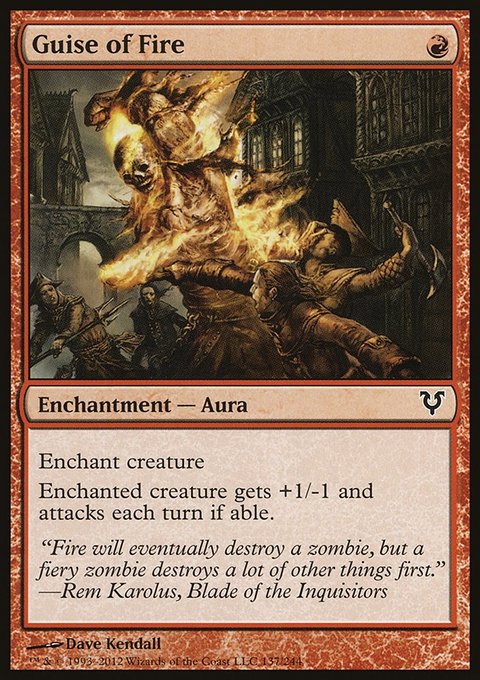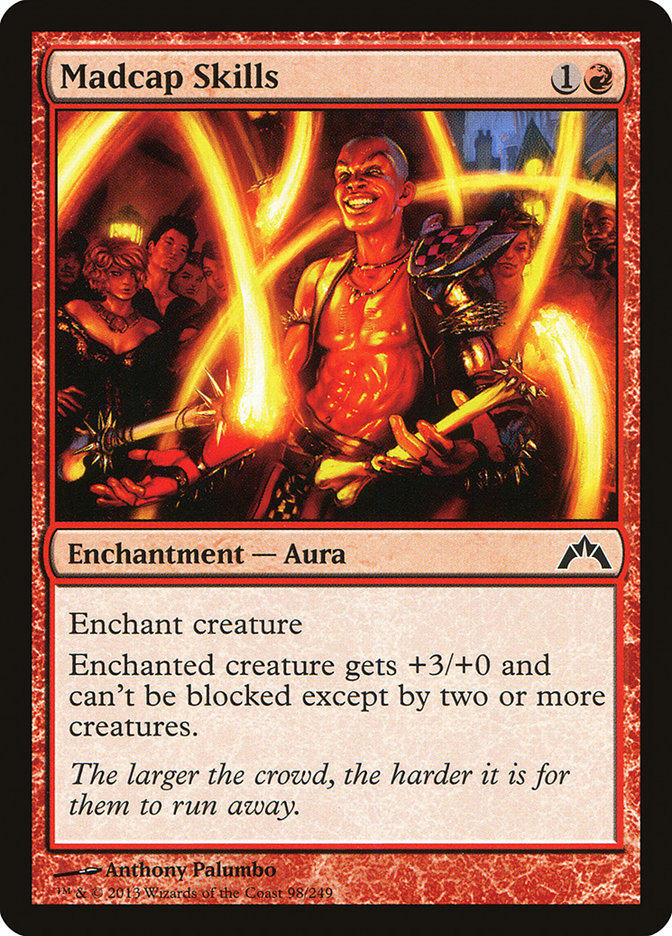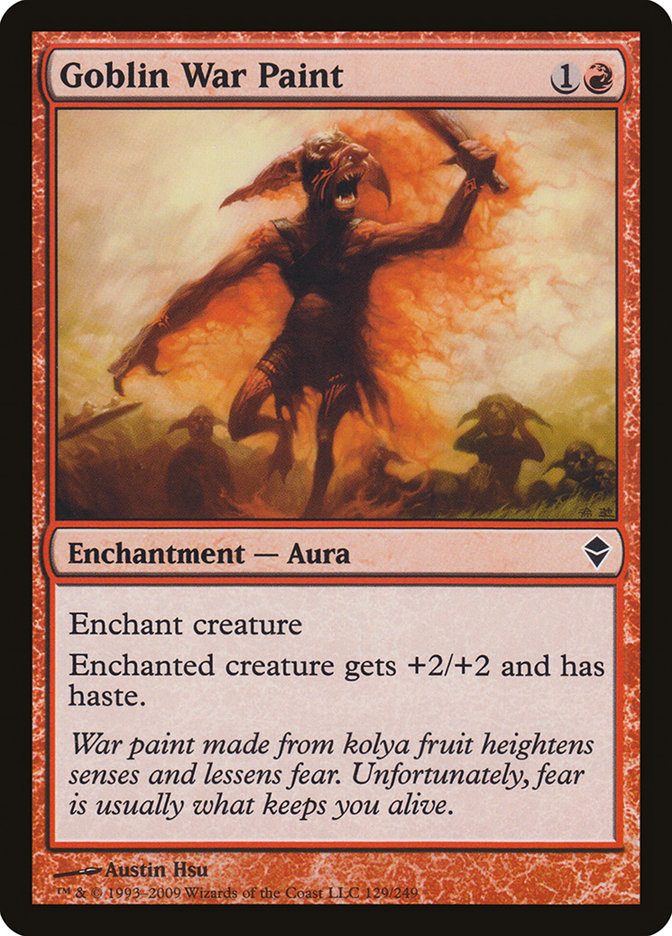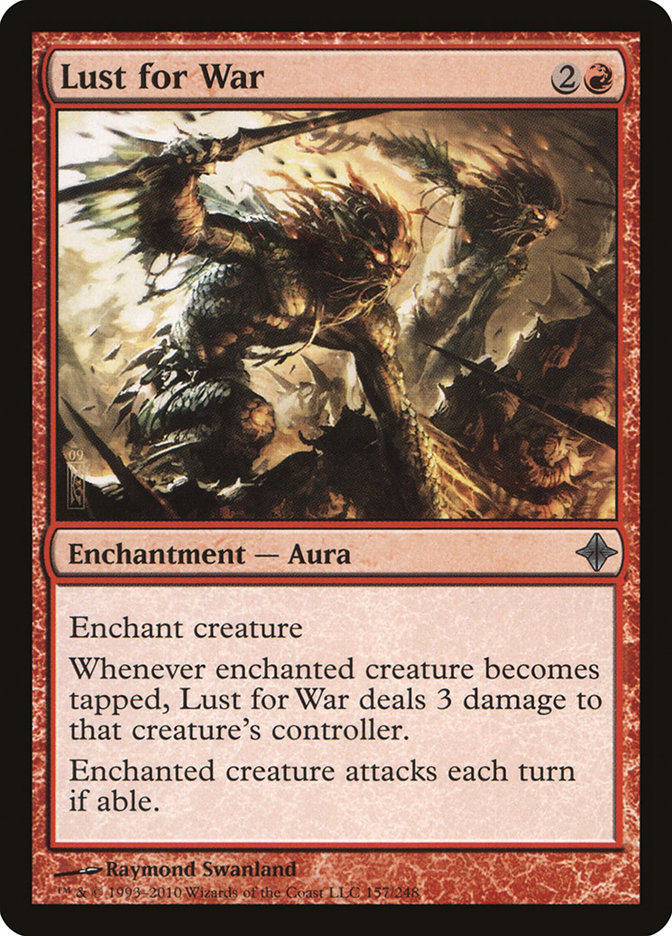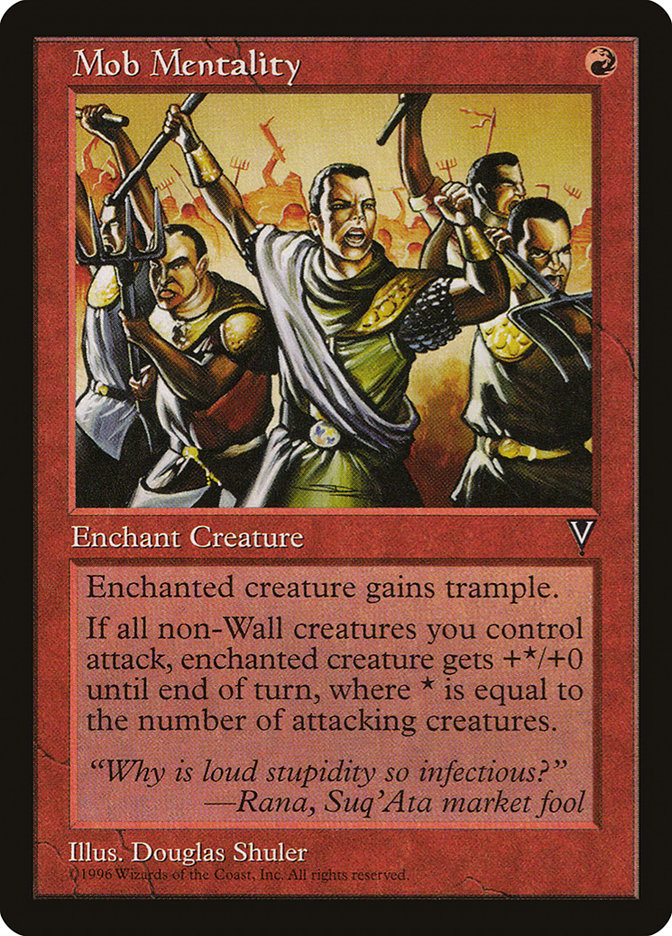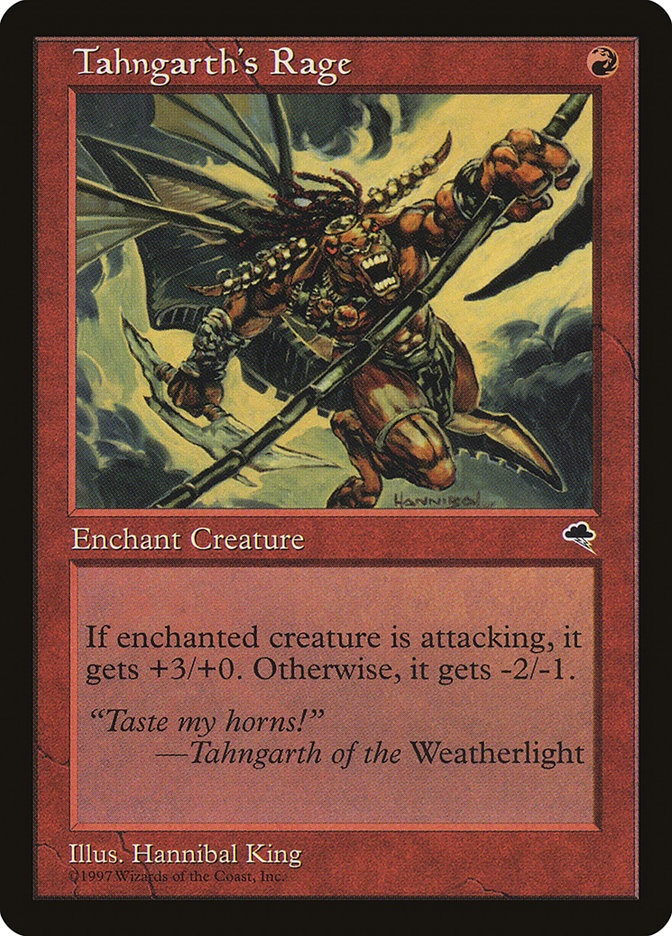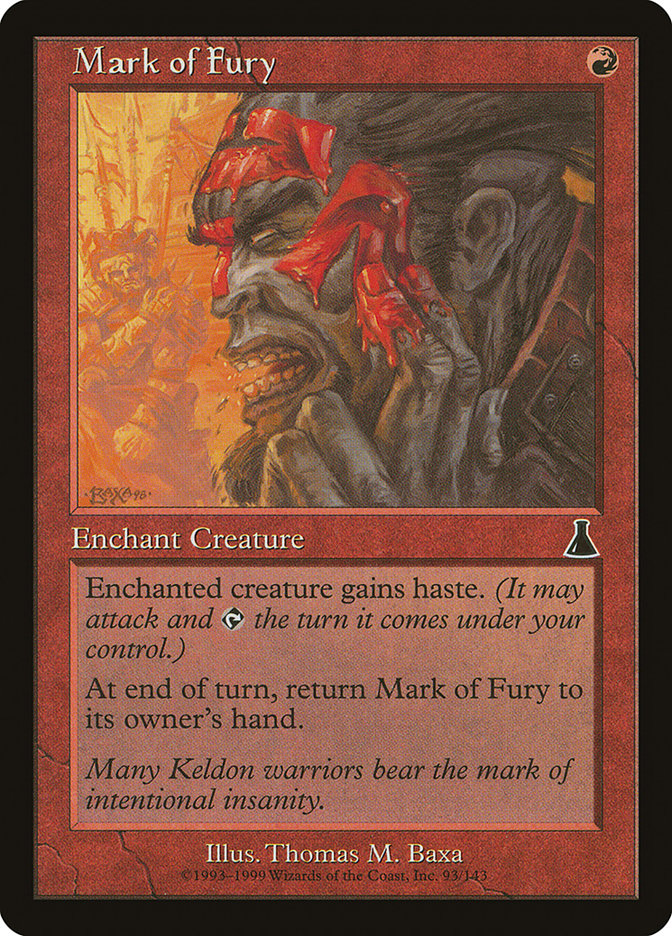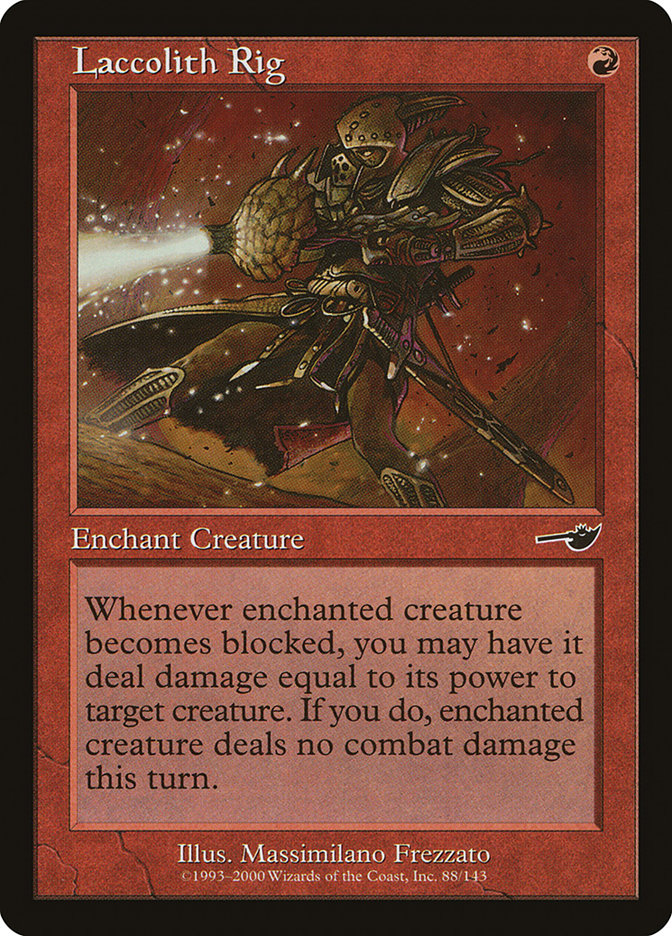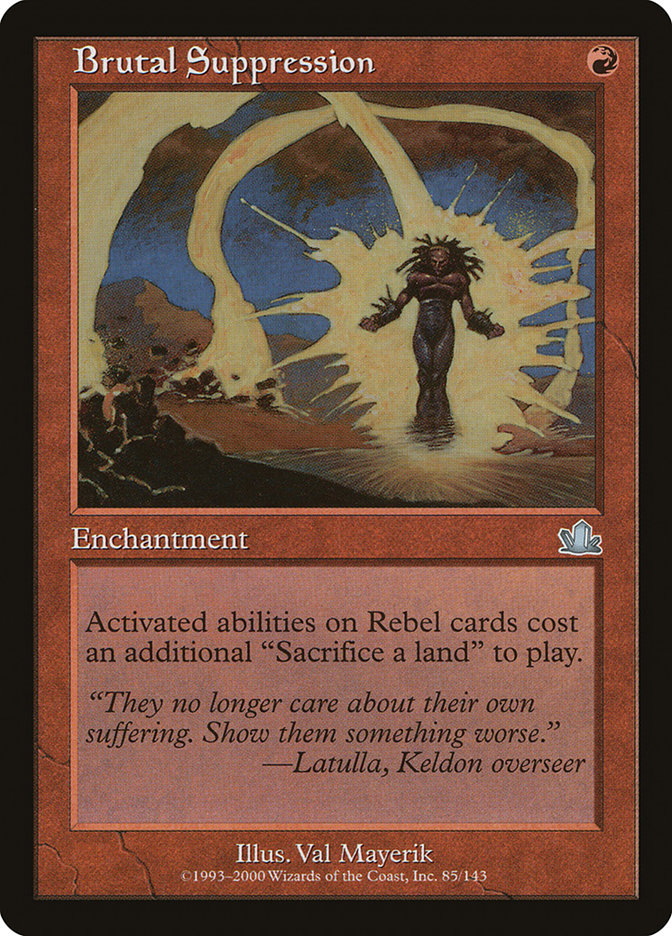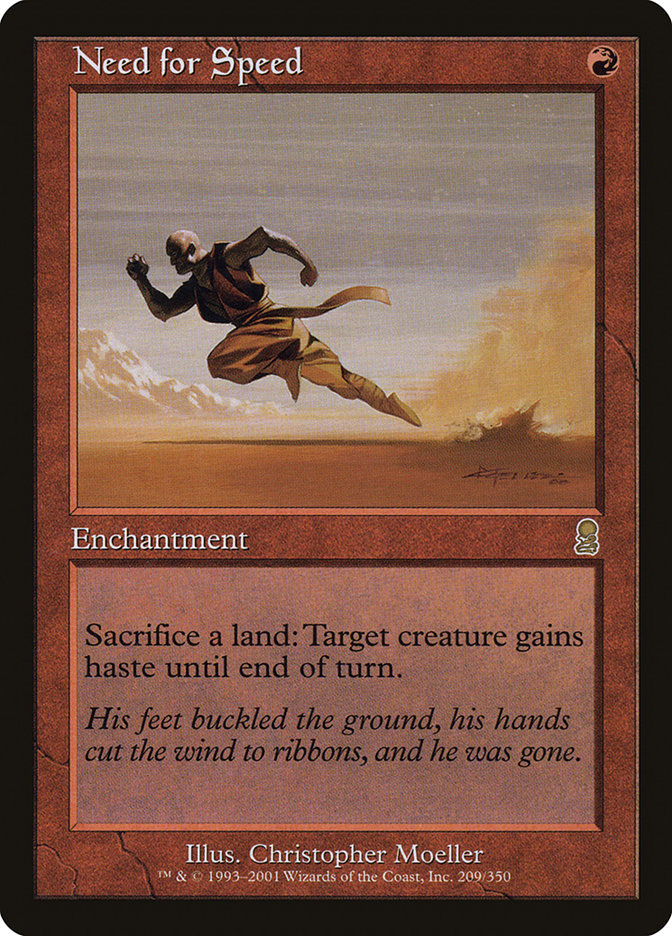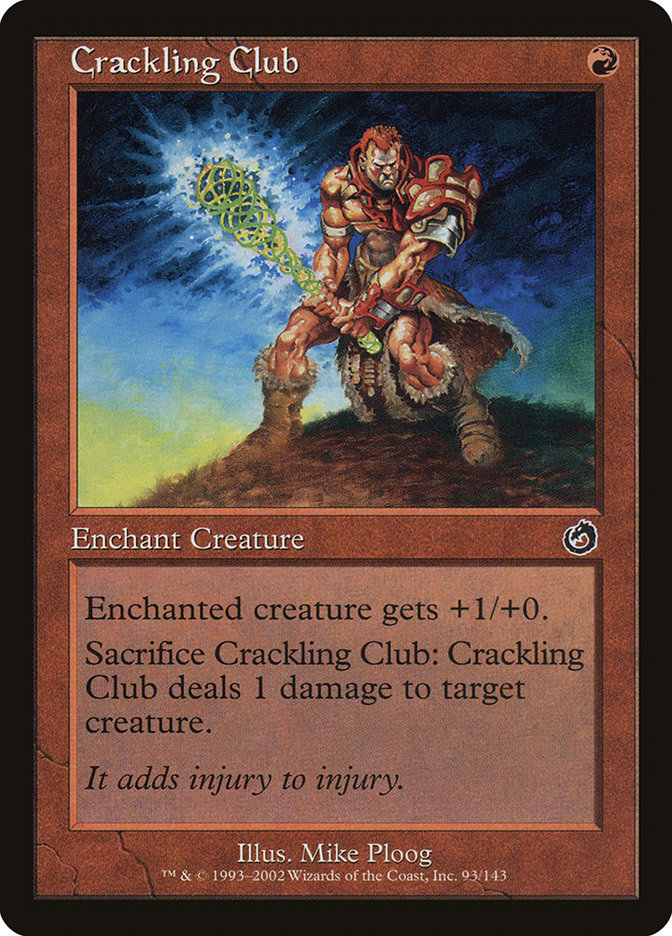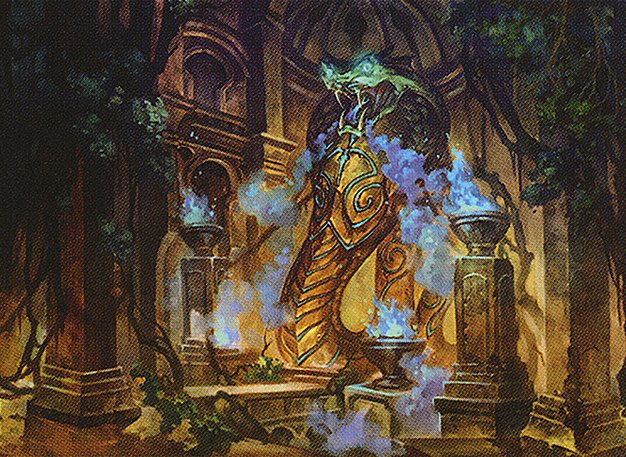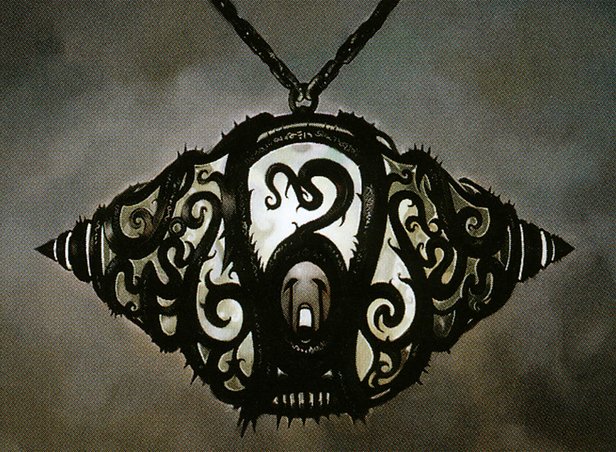Guise of Fire MTG Card
| Mana cost | |
| Converted mana cost | 1 |
| Rarity | Common |
| Type | Enchantment — Aura |
| Abilities | Enchant |
| Released | 2012-05-04 |
| Set symbol | |
| Set name | Avacyn Restored |
| Set code | AVR |
| Number | 137 |
| Frame | 2003 |
| Layout | Normal |
| Border | Black |
| Illustred by | Dave Kendall |
Key Takeaways
- Reduces opponents’ combat abilities, possibly necessitating they commit more resources to remain competitive.
- Strategic instant-speed use can force opponents into less optimal plays, enhancing your battlefield control.
- While versatile and impactful, the discard requirement and specific mana cost may limit its inclusion.
Text of card
Enchant creature Enchanted creature gets +1/-1 and attacks each turn if able.
"Fire will eventually destroy a zombie, but a fiery zombie destroys a lot of other things first." —Rem Karolus, Blade of the Inquisitors
Card Pros
Card Advantage: Guise of Fire really shines when it comes to disrupting your opponent’s strategy. By giving a creature -1/-1, it may reduce the number of effective blockers or attack-ready creatures, potentially clearing a path for your own attacks. Furthermore, its ability to deal 1 damage to the enchanted creature’s controller whenever the creature attacks keeps you ahead in the damage race, subtly tipping the scales in your favor.
Resource Acceleration: Although not a direct accelerant, Guise of Fire can be considered a form of resource acceleration as it reduces the effectiveness of your opponent’s creatures, possibly forcing them to invest more mana and cards into deploying additional threats. This indirect pressure can buy you the time and space needed to develop your board and utilize your mana more efficiently in the longer term.
Instant Speed: The key to Guise of Fire’s flexibility lies in its enchant creature nature. It can be played at sorcery speed, allowing you to immediately apply pressure on your opponent’s turn. While not an instant itself, the ability to disrupt at the beginning of your opponent’s combat phase can create advantageous situations and force them to react with haste, often at the cost of optimal plays.
Card Cons
Discard Requirement: Guise of Fire’s playability can be directly impacted by the need to sacrifice a card, which can put you at a disadvantage if you’re already behind your opponent in card advantage.
Specific Mana Cost: This card’s casting cost demands red mana, necessitating a commitment to red mana sources in a player’s deck, potentially limiting the range of decks in which this card can be effectively incorporated.
Comparatively High Mana Cost: For the aura and its specific ability enhancement, the mana investment might be considered steep relative to other enchantments with similar or greater impact on gameplay, potentially making this card a less optimal choice in deck construction.
Reasons to Include in Your Collection
Versatility: Guise of Fire is an adaptable addition to any deck aiming to control creatures on the board. With its ability to attach to opponent’s creatures and curtail their combat effectiveness, this card slots into various red strategies that prioritize tempo and control.
Combo Potential: This enchantment offers synergy with damage amplifiers or cards that penalize creatures for being tapped. It can be a cog in a machine that turns any creature into a liability for your opponent.
Meta-Relevance: In metagames where utility creatures play a key role, Guise of Fire becomes a meaningful sideboard card or even a main deck choice. It’s particularly potent against decks that depend on early creature aggression or those that rely on tapping abilities.
How to beat
Guise of Fire is a unique aura in Magic: The Gathering that can subtly tip the scales of battle by decreasing an opposing creature’s power, while also rendering it unable to block. To efficiently counter this red enchantment spell, players should consider strategies that remove enchantments from the battlefield or include creatures with hexproof or shroud in their decks. Such creatures are impervious to being targeted by not only Guise of Fire but by all other targeted spells, making them a reliable safeguard against this and similar threats.
Additionally, leveraging instant spells that can destroy or bounce enchantments back to an opponent’s hand, like Naturalize or Disperse, provide a quick and effective solution to reclaim full control of your creatures. Furthermore, careful management of the board state and maintaining a diverse array of creatures will dilute the impact that a single Guise of Fire can have on your side of the battlefield. Preparing versatile responses within your deck construction is the surest way to triumph against cards like Guise of Fire that attempt to manipulate creature dynamics.
Effective deck building and smart gameplay choices therefore mark the path to overcoming the challenges that Guise of Fire presents to MTG players, ensuring that one card does not combust their carefully laid plans.
Understanding the Heat of Battle
In the realm of Magic: The Gathering, certain cards possess the power to tip the scale of combat in subtle yet impactful ways. Guise of Fire is such a spell, slotting seamlessly into strategies keen on modifying creature abilities. With its ability to both give a creature +1 attack and force it to attack each turn if able, it is a nuanced tool for red mages.
Cards like Guise of Fire
Guise of Fire conjures up a direct comparison with cards like Madcap Skills and Goblin War Paint. Each of these spells boosts a creature’s power. However, Madcap Skills also grants an additional evasion benefit, allowing the creature to be blocked by two or more creatures. This aspect dramatically increases the creature’s survivability in combat scenarios. On the contrary, Goblin War Paint offers a similar power boost without imposing a forced combat duty but at the cost of additional mana.
Focusing on the aspect of mandatory attack, cards like Lust for War and Goblin Diplomats also share this trait, with Lust for War attaching to an opponent’s creature, effectively turning it into a relentless attacker that chips away at their owner’s life total each turn. Similarly, Goblin Diplomats can force all creatures to throw down in battle, shaping the entire battlefield with a simple tap.
Taking note of these aspects positions Guise of Fire as a potential surprise play in red decks, aimed at either empowering your assault or ensnaring an opponent’s key creature in a risky attack. This precision makes it a worthy inclusion for certain tactical approaches in Magic: The Gathering.
Cards similar to Guise of Fire by color, type and mana cost
Where to buy
If you're looking to purchase Guise of Fire MTG card by a specific set like Avacyn Restored, there are several reliable options to consider. One of the primary sources is your local game store, where you can often find booster packs, individual cards, and preconstructed decks from current and some past sets. They often offer the added benefit of a community where you can trade with other players.
For a broader inventory, particularly of older sets, online marketplaces like TCGPlayer, Card Kingdom and Card Market offer extensive selections and allow you to search for cards from specific sets. Larger e-commerce platforms like eBay and Amazon also have listings from various sellers, which can be a good place to look for sealed product and rare finds.
Additionally, Magic’s official site often has a store locator and retailer lists for finding Wizards of the Coast licensed products. Remember to check for authenticity and the condition of the cards when purchasing, especially from individual sellers on larger marketplaces.
Below is a list of some store websites where you can buy the Guise of Fire and other MTG cards:
- eBay
- TCG Player
- Card Kingdom
- Card Market
- Star City Games
- CoolStuffInc
- MTG Mint Card
- Hareruya
- Troll and Toad
- ABU Games
- Card Hoarder Magic Online
- MTGO Traders Magic Online
See MTG Products
Legalities
Magic the Gathering formats where Guise of Fire has restrictions
| Format | Legality |
|---|---|
| Commander | Legal |
| Legacy | Legal |
| Paupercommander | Legal |
| Modern | Legal |
| Oathbreaker | Legal |
| Pauper | Legal |
| Vintage | Legal |
| Duel | Legal |
| Penny | Legal |
Rules and information
The reference guide for Magic: The Gathering Guise of Fire card rulings provides official rulings, any errata issued, as well as a record of all the functional modifications that have occurred.
| Date | Text |
|---|---|
| 2012-05-01 | If, during its controller’s declare attackers step, the enchanted creature is tapped, is affected by a spell or ability that says it can’t attack, or hasn’t been under that player’s control continuously since the turn began (and doesn’t have haste), then it doesn’t attack. If there’s a cost associated with having a creature attack, the player isn’t forced to pay that cost, so it doesn’t have to attack in that case either. |
| 2012-05-01 | The controller of the enchanted creature still decides which player or planeswalker the creature attacks. |
